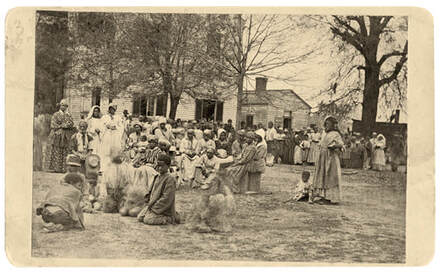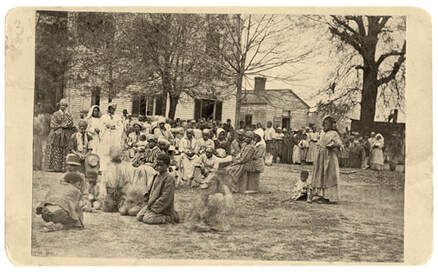|
Marshall Stearns as Superintendent of Negro Labor managed this “contraband” camp in Baton Rouge. Self-liberated slaves from Confederate plantations who reached union lines were designated by the Union “contraband of war.” This status aimed to prevent their return to their masters.
The occupants in the “contraband” yard shown here are overwhelmingly children, women, and older men. Able-bodied men (and perhaps some women) were recruited to work on Confederate plantations confiscated by the Union, often for wages. Others enlisted in the United States Colored Troops. African American families that had been disrupted or torn apart often reconstituted themselves in the “contraband” camps. One of their first requests was to have their marriages formalized, sealing bonds that were not officially recognized under slavery. |
The population of the “contraband” camp rose from some four hundred in mid-December 1862 to over a thousand by January 1863. It would soon soar to two thousand with about three thousand more located on the confiscated plantations.
The number of slaves in camp continues to increase and now reaches upwards of 600. Lt. Stearns of the 52d has charge of them…. The slaves generally come into our lines in the night, in squads. Letters from the 52d Regiment, Baton Rouge, LA, January 1, 1863 Hampshire Gazette and Northampton Courier There are now about 1300 contrabands in camp, and about 400 have been sent down the river for various purposes. Nearly 2000 have entered our lines since the present force came here. They do not come as fast now as during the first month after we arrived.… They are mostly field hands, but there are among them quite a number of mechanics.... I do not think they are, in their present situation, herded together like sheep, any better off than they were at home, but nevertheless they won’t go back, they have the idea that they are to be free…. It will take a considerable time to get a judicious system for treating them, in operation. Letters from the 52d Regiment, Baton Rouge, LA, January 31, 1863 Hampshire Gazette and Northampton Courier |
Bondspeople who fled plantation slavery arrived in horrid conditions – weakened, famished, and dressed in rags or, as Stearns wrote his mother, “nearly naked.” Stearns needed to supply proper food and clean clothing. Due to overcrowding and disease, many encountered sickness and death. “The race are in a state of chaotic freedom,” Gere informed the homefront.
Maria Kline, a self-liberated enslaved woman, volunteered to help Stearns manage his camp. After organizing a massive commissary, her first order of business was to improve the sewing skills of the women to work thousands of yards of Union cloth into clothing. They also managed to distribute crude shoes.
Gere described the hardships for Hampshire Gazette readers:
“Many of them have died here – it is not unusual for three or four to die in one day. They are very sensitive to the cold, and it is probably the want of sufficient clothing that causes them to sicken and die so rapidly. The government cares for them as well as is possible under the confused circumstances attending their sudden gathering, and has already supplied them with $12,000 worth of articles besides their provisions.”
Letters from the 52d Regiment, Baton Rouge, LA, January 31, 1863
Hampshire Gazette and Northampton Courier
Self-liberated slaves faced re-enslavement when planters or their agents showed up at the camp to claim them. Marshall Stearns refused to give them up.
Stearns wrote to his family how he dealt with “Secesh [Secessionist] gents and women when they want their slaves back.” “I go to the Quarters,” he explained and “let them pick them out,” without bothering to ask whether they were pro-Union or not. He describes what typically follows:
“They make speeches about no one to help them, and then I say ‘Do you want to go home with her?’ The answer is “no’ in every case. The negro says she has been abused and … stripped her shoulder bare to the hide (as they term it) and took 20 to 40 stripes. I listen a minute and then tell the seccesh [secessionist] sister than she cannot have her servant. This happens over and over.”
Maria Kline, a self-liberated enslaved woman, volunteered to help Stearns manage his camp. After organizing a massive commissary, her first order of business was to improve the sewing skills of the women to work thousands of yards of Union cloth into clothing. They also managed to distribute crude shoes.
Gere described the hardships for Hampshire Gazette readers:
“Many of them have died here – it is not unusual for three or four to die in one day. They are very sensitive to the cold, and it is probably the want of sufficient clothing that causes them to sicken and die so rapidly. The government cares for them as well as is possible under the confused circumstances attending their sudden gathering, and has already supplied them with $12,000 worth of articles besides their provisions.”
Letters from the 52d Regiment, Baton Rouge, LA, January 31, 1863
Hampshire Gazette and Northampton Courier
Self-liberated slaves faced re-enslavement when planters or their agents showed up at the camp to claim them. Marshall Stearns refused to give them up.
Stearns wrote to his family how he dealt with “Secesh [Secessionist] gents and women when they want their slaves back.” “I go to the Quarters,” he explained and “let them pick them out,” without bothering to ask whether they were pro-Union or not. He describes what typically follows:
“They make speeches about no one to help them, and then I say ‘Do you want to go home with her?’ The answer is “no’ in every case. The negro says she has been abused and … stripped her shoulder bare to the hide (as they term it) and took 20 to 40 stripes. I listen a minute and then tell the seccesh [secessionist] sister than she cannot have her servant. This happens over and over.”
- Letter, Marshall Stearns to his Mother, January 8, 1863
- State Library of Massachusetts, State House, Boston

